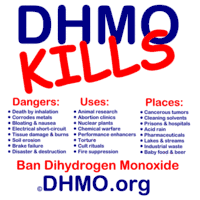Water
Water (H2O) is a chemical compound. Each molecule consists of two hydrogen atoms and one oxygen atom sharing covalent bonds. Its chemical name is dihydrogen monoxide. (See below.)

| The poetry of reality Science |
| We must know. We will know. |
| A view from the shoulders of giants. |
v - t - e |
Chemical properties


Water is an excellent solvent and it is often referred to as the "universal solvent" or even the "solvent of life". The water molecule's structure is responsible for this, since the electrons are unevenly distributed throughout the molecule. One end of the molecule with greater electron density is slightly negative and the other slightly positive. Water and related compounds are said to be "polar". Water generally dissolves other substances that are also polar.
Non-polar substances, like oil, will not dissolve in water. Water's polar nature explains many of its properties, some of them essential for life as we know it, like its (relatively) high melting and boiling points, high surface tension, and that it expands while freezing (in other words, unlike many other substances water ice is less dense than liquid water).
Non-polar substances can be made to be soluble in water by using detergents (also called surfactants) that are large molecules with a polar end and a non-polar end. The polar end is attracted to water molecules and the non-polar end to the non-polar greasy substances.[1]
Water in the Universe
Carbon, hydrogen, oxygen, and nitrogen are the most common elements in the cosmos. Unsurprisingly, water is the most abundant compound of the Universe[2], and can be found elsewhere: from some craters of the polar regions of the Moon to a very distant quasar[3], However this is the only place of the Universe where liquid water has been observed[4]
Water and life
Many exobiologists consider the presence of liquid water to be a necessary condition for the development of life. While this is a bit earth-centric, it is quite likely true for chemical life as we are familiar with it.
Water on Earth
On Earth, water exists naturally in all three states, as ice, liquid water, and water vapor. The water cycle drives most of our weather, by transporting large amounts of energy received from the sun into the atmosphere, where it can then move from place to place, often forming large cyclonic patterns due to the Earth's rotation.
Had we seen our planet from space in olden days, we would have called it "Water," not "Earth." Then again, had we seen our planet in cross-section in olden days, we probably would have called it "Silicate and Iron".
How Earth got water is not fully determined. The dominant hypotheses suggest that meteorites or comets littered Earth with liquid water or otherwise helped form the water, but an August 2020 study published in Science suggests that at least a portion of the water may have already formed during Earth's building process, as the deuterium-to-hydrogen ratio in common meteorites were similar to the ratio inside Earth.[5]
Water and religion
Dunking water on the head of a baby or adult, alternatively immersing the aforementioned baby/adult in water is a ritual that’s relatively harmless in itself unless there are germs in the water. Despite this the ritual is all too often the start of a process or part of a process that erodes critical thinking and encourages unquestioning faith.[note 1]
Dihydrogen monoxide

“”Dihydrogen monoxide, or, "How I learned to use technical jargon to feel self-superior and get a cheap laugh at the expense of others." |
Dihydrogen monoxide (frequently abbreviated DHMO) is an alternative name for water based on its chemical composition. The use of technical jargon lends an air of danger to an everyday substance. One can then list a range of harmful effects associated with the chemical, playing upon the listeners' chemophobia, thus leading people to believe that dihydrogen monoxide poses a threat to public safety and should be banned. People who fall for this can then be called gullible misguided.[6] Great hilarity will then ensue.[7]
There is actually an important point to be made about the dihydrogen monoxide stunt. As the above shows, it can be tough to tell the difference between real science and a deliberate hoax. Often, we have to take accredited scientists at their word when they tell us about complicated topics such as black holes, quantum mechanics, brain physiology or any number of other topics that the lay person probably does not really understand. People generally hold scientists in high regard. Alas, the scientifically illiterate often "reason", if one can call it such, according to fear, uncertainty, and doubt. Even intelligent people are sometimes taken in and hilarity may not be justified. This may help explain why otherwise smart people can fall for pseudoscience.
| For those of you in the mood, RationalWiki has a fun article about Dihydrogen monoxide. |
See also
Notes
- However, the ritual itself doesn't actually do anything, as there is really nothing magical about the water. It's the ensuing brainwashing that really matters.
References
- http://www.newton.dep.anl.gov/askasci/chem00/chem00045.htm
- Water - The most abundant compound in the Universe - Science Is Life (now, how does it feel to pay for a bottle of it the same as if it was Unicorn's blood instead?)
- Astronomers Find Largest, Most Distant Reservoir of Water
- There's strong evidence of liquid water on Mars' surface, and some moons of the outermost planets, as Europa in Jupiter or Titan in Saturn, are very likely to have subsurface oceans under thick icy crusts.
- Pelsier, A. (August 28, 2020). The origins of water. Science, 369(6507), p1058. doi:10.1126/science.abc1338 , cited in National Public Radio, "Water, Water, Every Where — And Now Scientists Know Where It Came From". Retrieved September 1, 2020.
- When Penn and Teller replicated the DHMO stunt on the environmentalism episode of Bullshit!, Penn mocked "we got signatures right and left. Well, mostly left."
- http://www.snopes.com/science/dhmo.asp